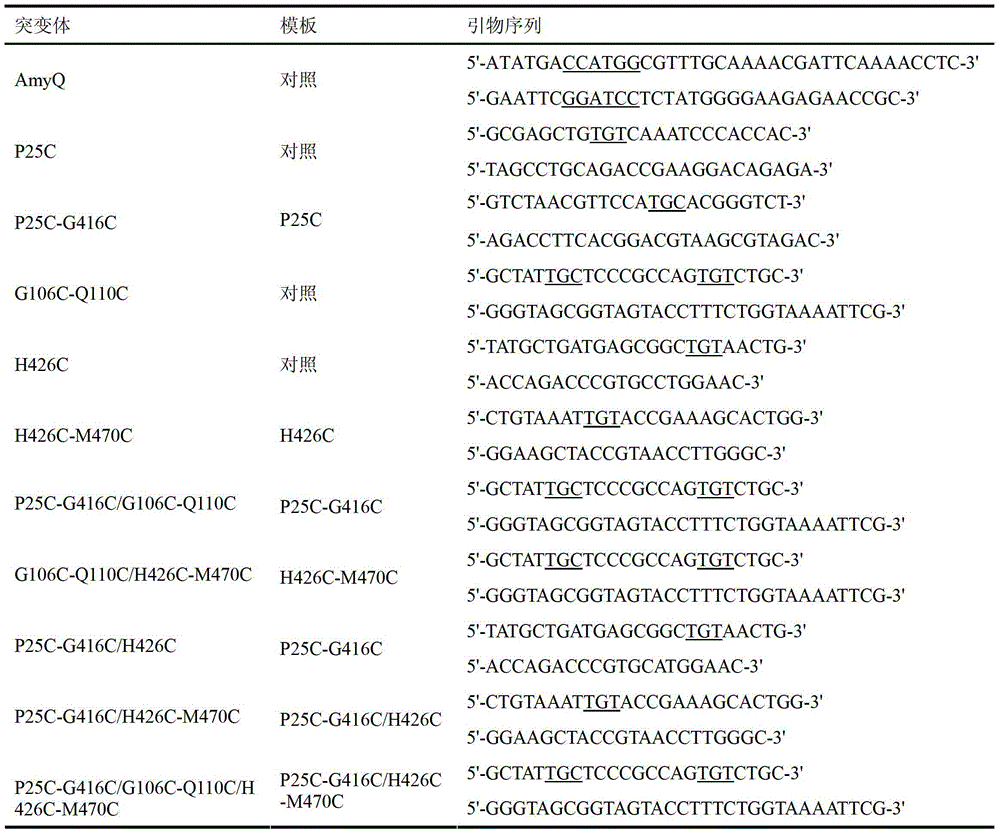Thermostable amylase mutant and a preparation method as well as application thereof
An amylase and mutant technology, applied in the field of alkaline amylase mutants and their preparation, can solve problems such as poor stability, achieve the effects of improved thermal stability, broad application prospects, and shortened transformation time
- Summary
- Abstract
- Description
- Claims
- Application Information
AI Technical Summary
Problems solved by technology
Method used
Image
Examples
Embodiment 1
[0018] Example 1: Site-directed mutation analysis and method of amylase thermal stability
[0019] Use Swiss-model software to simulate amylase derived from Bacillus alkalophila (SEQ ID NO.1) to obtain the spatial structure of amylase, use software Disulfide by Design TM Predict the possible disulfide bonds in the structure of amylase. On this basis, the Swiss-model is used to simulate the spatial structure of the enzyme after mutation, and the Discovery Studio software is used to analyze whether disulfide bonds are formed, and the amino acid sites that can form disulfide bonds are obtained. Finally, the Discovery Studio software was used to analyze the impact of amino acid site mutations that can form disulfide bonds on the formation of hydrogen bonds and salt bridges in the enzyme molecule. At the same time, considering the distance between the mutation site and the active center, it was finally determined to introduce disulfide in the amylase catalytic domain. Sulfur bond sit...
Embodiment 2
[0024] Example 2: Site-directed mutation analysis and method of amylase thermal stability
[0025] DNS method for measuring alkaline amylase activity:
[0026] 1) Preparation of DNS reagent: Weigh 3.25g of 3,5-dinitrosalicylic acid and dissolve in a small amount of water, transfer it into a 500mL volumetric flask, add 162.5mL of 2mol / L sodium hydroxide solution, then add 22.5g of glycerol, shake Evenly, dilute to 500mL, and store in a brown bottle in a refrigerator at 4°C for later use.
[0027] 2) Preparation of glucose standard curve: prepare glucose solutions with different concentrations of 0.2g / L-1.0g / L. Take 1mL of glucose of different concentrations and mix with the same volume of DNS solution and put it in a boiling water bath for 10 minutes. Cool with cold water, dilute to 10mL, A 540 Determine the absorbance value. Take the concentration of glucose as the abscissa and the absorbance as the ordinate to make a standard curve.
[0028] 3) Add 1 mL of 2% soluble starch to the...
Embodiment 3
[0033] Example 3: Determination and analysis of the thermal stability of amylase at 60°C
[0034] Through the measurement, it was found that the half-life of single-pair disulfide bond mutants P25C-G416C, G106C-Q110C and H426C-M470C at 60°C (Table 2) all increased, and G106C-Q110C had the most significant effect, with the half-life increased to 3.3 times the original . On this basis, a combination of mutations was performed, and four mutants of P25C-G416C / G106C-Q110C, P25C-G416C / H426C-M470C, G106C-Q110C / H426C-M470C and P25C-G416C / G106C-Q110C / H426C-M470C were obtained. It was found that their half-life at 60°C (Table 3) was improved. Among them, the six mutants P25C-G416C / G106C-Q110C / H426C-M470C, which can form three pairs of disulfide bonds, had the most significant effect, and the half-life was increased to the original 7 times. The amylase has strong thermal stability under alkaline conditions.
[0035] Table 2 Thermal stability of single-pair disulfide bond recombinase at 60℃...
PUM
 Login to View More
Login to View More Abstract
Description
Claims
Application Information
 Login to View More
Login to View More - R&D
- Intellectual Property
- Life Sciences
- Materials
- Tech Scout
- Unparalleled Data Quality
- Higher Quality Content
- 60% Fewer Hallucinations
Browse by: Latest US Patents, China's latest patents, Technical Efficacy Thesaurus, Application Domain, Technology Topic, Popular Technical Reports.
© 2025 PatSnap. All rights reserved.Legal|Privacy policy|Modern Slavery Act Transparency Statement|Sitemap|About US| Contact US: help@patsnap.com



